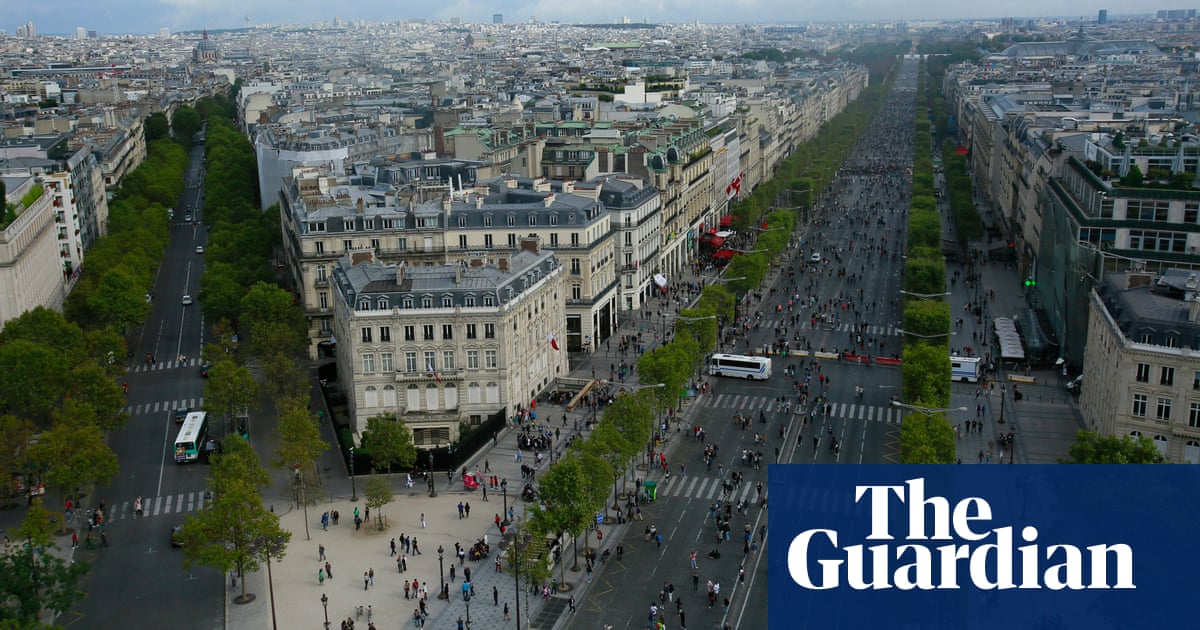
On paper and in urban legend, the Champs-Élysées is the most beautiful avenue in the world. For the last 30 years, however, Parisians have lamented the slow decline of the capital’s famous street.
The pavements flanking what is now an eight-lane highway used by an average 3,000 vehicles an hour have become an obstacle course of uneven paving stones and electricity cables and a hotchpotch of restaurant, bar, cafe and brasserie terraces of all shapes, sizes and colours.
With Paris hosting the Olympic Games next year, local traders and businesses have decided enough is enough. They say they cannot wait for a multimillion-euro project to turn the wider area into what Paris’s city hall has called an “extraordinary garden”, scheduled to start after the Games. Instead, they have approved a plan to give the avenue an urgent cosmetic makeover.
“The world’s most beautiful avenue cannot have the ugliest terraces in France,” said Marc-Antoine Jamet, the president of the Champs-Élysées committee, unveiling the plan on Tuesday.
Under the plan, terraces are to be standardised and aligned to ease the flow of pedestrians – up to 300,000 of them on busy days. Roof awnings will be green on the outside but establishments can personalise their terrace with a choice of furniture and four interior colours.
The alignment is intended to open up the vista between Place de la Concorde and the Arc de Triomphe and allow more of the avenue’s historic facades to be seen.
In a nod to the environment and aesthetics, terraces with motorised blinds and awnings will be “energy autonomous” and fitted with rechargeable batteries with a 20-year lifespan to avoid covering the pavement with cables as at present.
The Champs-Élysées committee, which represents businesses and traders on the avenue, has campaigned for a major redesign of the venue and its surroundings for nearly six years.
It says the facelift was approved by all of its 180 members. Each terrace will cost about €400,000 (£350,000) and traders say they will foot the bill.
The committee’s plan still has to be approved by the city hall, which enforces regulations for terraces in the capital. But Jamet said the body already had an agreement in principle. If the Champs-Élysées plan is added to the municipal rulebook, establishments that fail to introduce the new terraces could face fines.
“On the eve of the Olympic and Paralympics, we could not allow the disparate, disorganised, somewhat motley and sometimes cobbled-together group of terraces on the Champs-Élysées to continue too much longer without proposing to improve their layout, organisation, form and colours,” Jamet said. “It’s a question of reputation. To achieve this, everyone had to agree.”
The terrace structures are traditionally known as “vacheries anglaises” (English cowsheds); the reason for this, apart from the similarity to farm buildings, is unexplained.
The new structures will be made in France and can be dismantled when the Champs-Élysées hosts events such as Bastille Day parades or demonstrations.
Out of the 19 establishments with terraces on the avenue, 17 have already ordered the new terraces, the committee said. If approved, the first of these will be installed in December, with all finished by April.
In January 2021 the Paris mayor, Anne Hidalgo, announced that a long-awaited development of the avenue and surrounding area, initially costed at €250m and first unveiled by local community leaders and businesses in 2019, would go ahead but not before the Games, to be held in August and September next year.
She said the plan would turn the 1.9km (1.2-mile) stretch of central Paris into “an extraordinary garden”.
The committee said after the mayor’s announcement: “The legendary avenue has lost its splendour over the last 30 years. It has been progressively abandoned by Parisians and has been hit by several successive crises: the gilets jaunes, strikes, health and economic.”











